This Blackened Alligator Étouffée Recipe has all those wonderfully rich, spicy, buttery flavors that we all love. And I tell you what...all of that combined with Blackened Alligator, and you've got a fantastic alternative to a more typical creole dish using crawfish or other seafood.
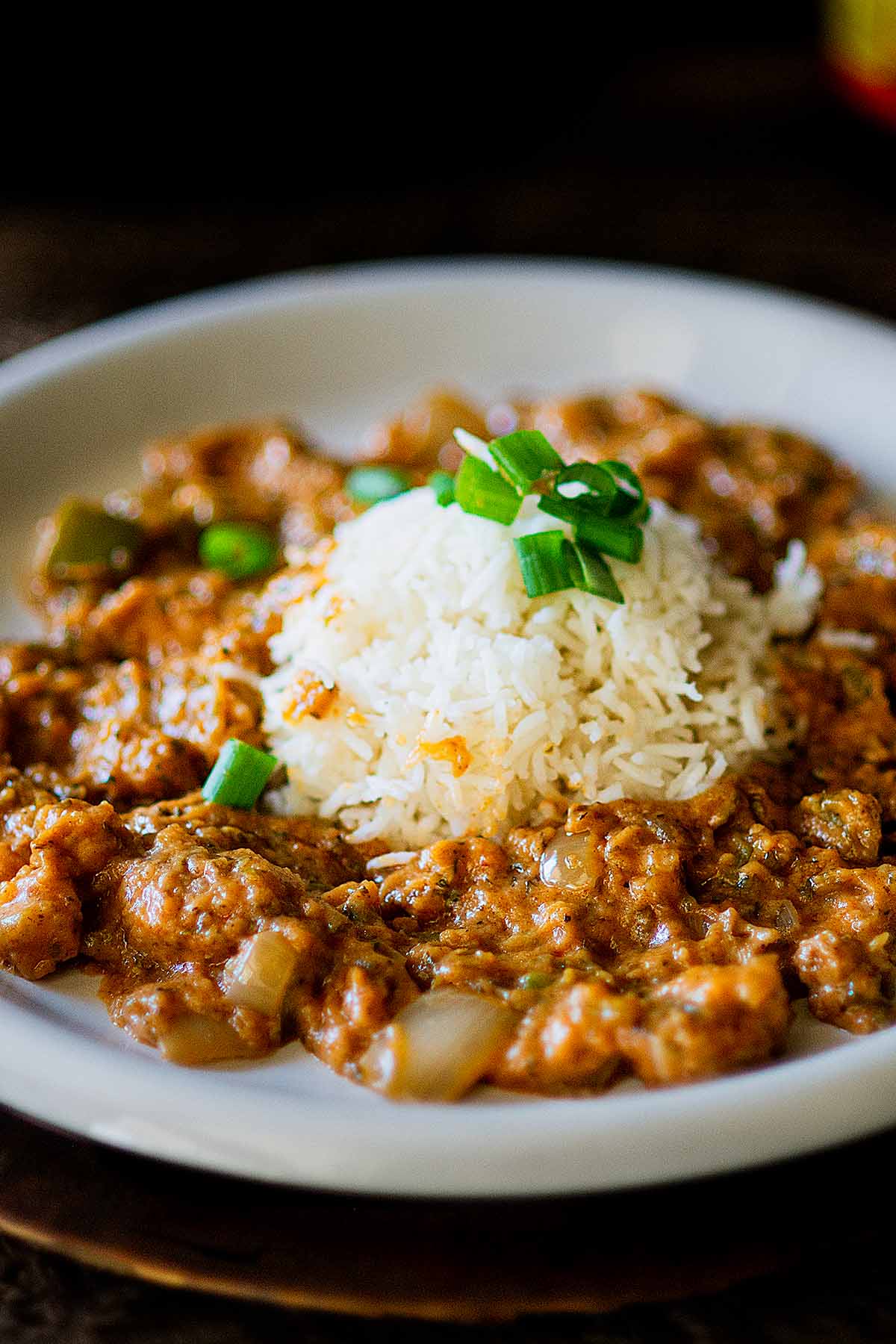
Most home cooks are very surprised at how easy learning how to make Étouffée really is. Adding blackened anything is fantastic, but when you have the chance to use alligator, it adds a whole other flavor profile and texture. When making this, I also like to make Slow Cooker Jambalaya and Gumbo. It's like a Creole buffet once a year, and that day is one of my favorites!
Jump to:
Why You'll Love This Recipe
While alligator meat isn't a shellfish in any way, shape, or form, it's perfect in a well-made étouffée. The meaty texture, slight fishy aftertaste, and richness add a new flavor profile. Plus, the addition of blackened seasoning thrives in its spiciness without being overdone, allowing all flavors to hold their own.
Ingredients
Meat: The only meat you'll need is an Alligator Steak.
Vegetables: You'll need Celery, Green Bell Peppers, Yellow Onions, and Green Onions.
Liquids: Salted Butter, Chicken Stock/Broth, Water, and Tomato Paste.
Seasonings, Herbs, and Spices: Dried Parsley, Kosher Salt, Ground Black Pepper, Cayenne, and Blackened Seasoning (see Expert Tips).
Extras: All Purpose flour, Cooked White Rice(for serving).
See the recipe card below for full information on ingredients and quantities.
Step-by-Step Instructions
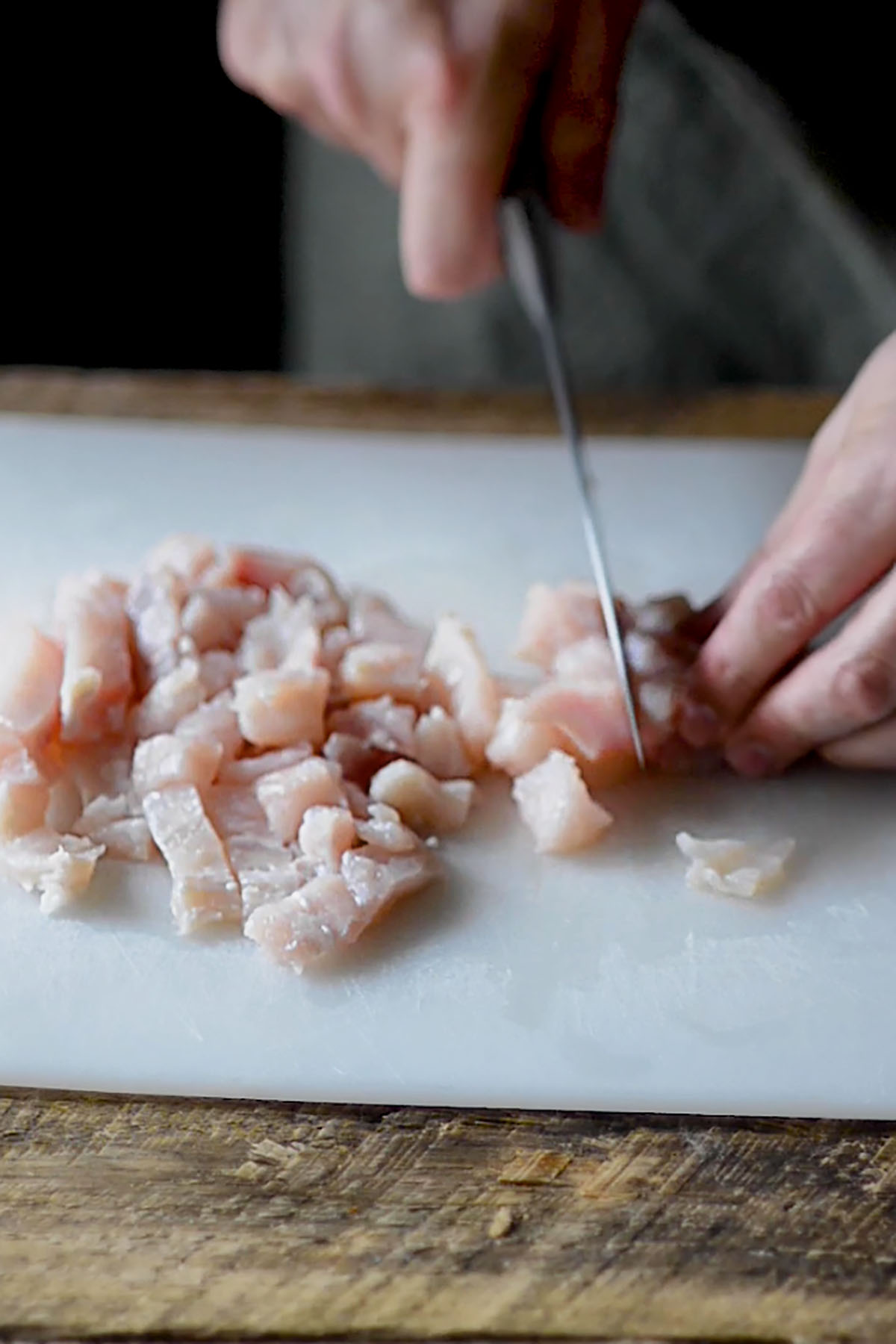
Step 1: First, start by slicing the alligator into small cubes. Alligator meat is slightly flaky and will fall apart a bit, which is good. But don't worry about making the pieces too small because they will shrink during the blackening process.
Next, place butter slices in a microwave-safe bowl and microwave for about 20-30 seconds until it just begins to melt, then stir in your favorite blackened seasoning. Add the cubed alligator to the butter mixture and stir to ensure it's all covered.
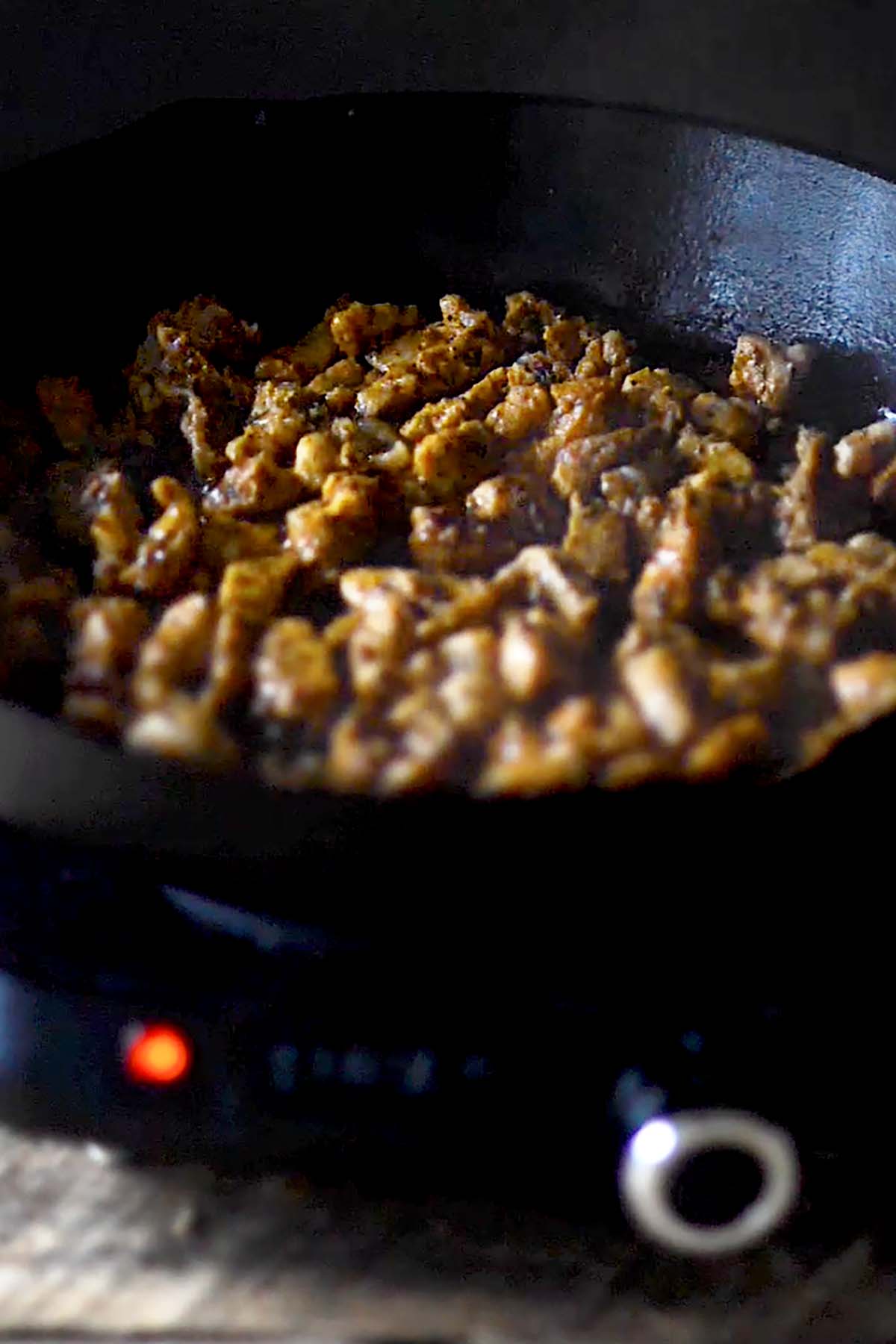
Step 2: Heat a cast iron skillet over high heat. Once the cast iron is fully heated, drop the butter-coated alligator into the skillet and cook, stirring frequently, until all sides are blackened with a bit of a crust, about 6-8 minutes. Remove the alligator from the skillet and set aside. Turn the heat off on the skillet and allow it to cool for about 15 minutes.

Step 3: Using the same cast iron skillet as before, set the heat to low and add the butter, allowing it to melt fully.
Add the flour and constantly stir until fully combined and the roux becomes a light caramel color. Add the holy trinity and stir, ensuring it's all fully coated in that silky blond roux.
Raise the heat to medium or medium-high. Stir in the chicken broth, water, tomato paste, salt, pepper, and cayenne. Bring this mixture to a boil and immediately reduce the heat to a simmer.
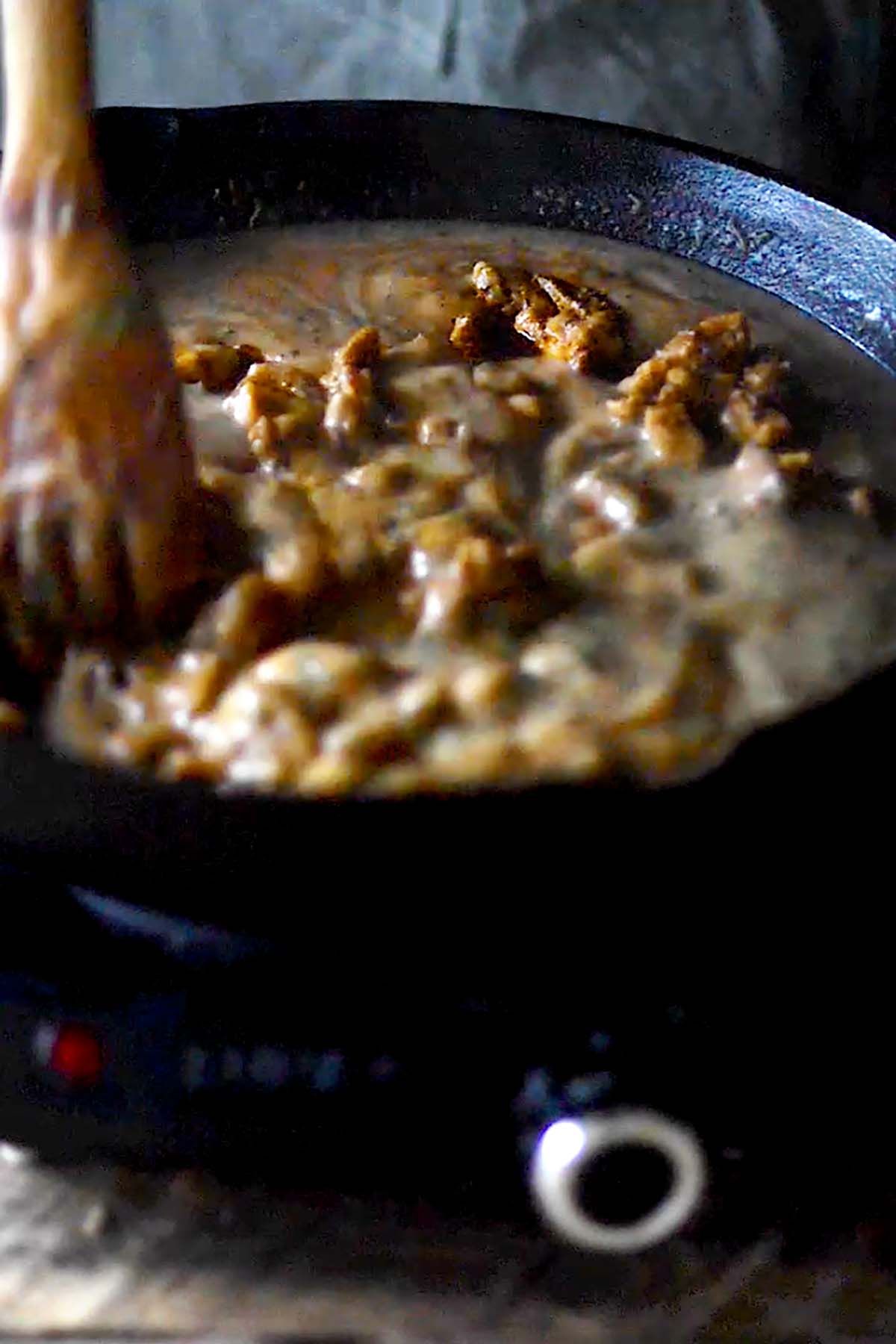
Step 4: Add the blackened alligator to the simmering Étouffée, cover, and allow the flavors to meld for about 20 minutes.
Serve over cooked white rice and garnish with sliced green onion.
Expert Tips
- Alligator meat can be found in the frozen seafood section of most grocery stores.
- Slightly melting the butter and adding the seasoning helps ensure all of the alligator meat is fully coated.
- When making the roux, be sure that you are constantly stirring. Do not let up, or you will end up with clumps.
Recipe FAQs
Many parts of the alligator are consumed, but most commonly, the meat comes from the tail. This is referred to as the "Filet Mignon" of alligators, also known as the tenderloin, and each tail has two tenderloins.
The white meat sections of the body and legs are also consumed but not as desirable.
Yes, Alligator meat is healthy!
Alligator is an extremely high protein, lean meat. One pound contains 1160 Calories, packed with 230g of protein and only 20g of total fat. In addition, alligator meat has ZERO saturated fat, cholesterol, or carbs. To further the point, it's a great source of omega-3 Fatty Acids and high in vitamin B-12.
Compare that to a 1 lb ribeye steak with around 1320 calories, only 108g of protein, 363 mg of cholesterol, and 98g of total fat, with 44g being saturated fat and 6.7 trans fat.
You can buy Alligator meat at most local grocery stores or large chains such as Walmart. Just check the frozen seafood section; it should be right there.
The two most common ways that alligator is cooked are to fry or blacken it. While frying is the most common, I prefer blackened alligator meat.
If you decide to try and fry it, it's really no different than any other recipe like chicken fried steak or chicken fried chicken.
Simply slice the alligator into nuggets and marinate them with a buttermilk, egg, and hot sauce blend for about an hour or so. Create a flour mixture of your choice. Right before frying, dredge the nuggets in the flour, back in the buttermilk mix, then again in the flour. Fry them in vegetable oil or shortening at 375° until golden brown on all sides.
Étouffée is a French word meaning smothered. It's a Creole or Cajun dish most popularly using crawfish but is also commonly found with crab or shrimp. The meat is smothered in a blond roux and always contains the holy trinity.
The difference between Creole and Cajun étouffée is the use of tomatoes in Creole cooking.
Crawfish Étouffée has been around since the '20s and was a popular dish in the backwaters of Louisiana. Around 1983, it became an instant hit at a restaurant on Bourbon Street called Galatoire's.
More Recipes You'll Love
If you made this Blackened Alligator Étouffée recipe or any other of my recipes, please leave a Star Rating and let me know your thoughts in the comments below.
Don't forget to tag @chickenfriedkitchen on Instagram, Subscribe on YouTube, and Follow on Pinterest and Facebook! I'll see you there!
📖 Recipe

How to Make Blackened Alligator Étouffée
Ingredients
- 1 Lb Alligator Meat
- 1 Cup Butter, divided
- ¼ Cup Blackened Seasoning
- ½ Cup all-purpose flour
- 1 Cup Celery, sliced
- 1 Cup Green Bell Pepper, diced
- 1 ¼ Cup Yellow Onion, Diced
- 14 ½ Oz Chicken Broth
- 1 Cup Water
- ¼ Cup Dried Parsley
- 1 tablespoon Tomato Paste
- ½ teaspoon Kosher Salt
- ¼ teaspoon Black Pepper
- ¼ teaspoon Cayenne Pepper
- Sliced Green Onion for Garnish
- Cooked White Rice for serving
Instructions
For the Alligator
- Microwave half a cup of butter for 30 seconds.
- Add ¼ cup of blackened seasoning to the melted butter and stir to combine.
- Cube the alligator meat and add to the butter mixture, stirring to coat the alligator.
- Heat a 12-inch cast iron skillet over high heat.
- Add the butter-coated alligator to the preheated skillet, occasionally stirring for about 5 minutes or until the alligator is blackened on all sides. Set aside.
For the Étouffée
- In the same skillet as before on low heat, melt ½ cup of butter.
- Stir all-purpose flour into the melted butter and cook over low heat until the roux becomes a light caramel color.
- Add Celery, Onion, and Bell Pepper to the roux and stir to coat.
- Pour in water and chicken broth, add the tomato paste, then parsley, salt, pepper, and cayenne.
- Bring to a boil, add the blackened alligator, and reduce to a simmer for about 20 minutes.
- Serve with cooked white rice and garnish with sliced green onion.
Video

Notes
- Alligator meat can be found in the frozen seafood section of most grocery stores.
- Slightly melting the butter and adding the seasoning helps ensure all of the alligator meat is fully coated.
- When making the roux, be sure that you are constantly stirring. Do not let up, or you will end up with clumps.

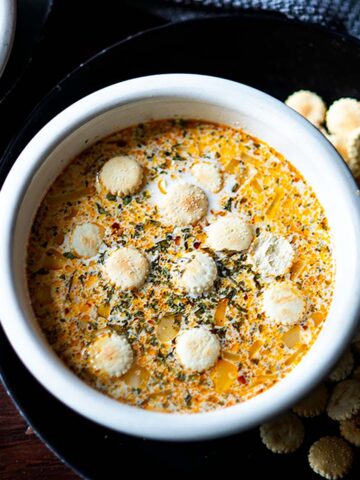
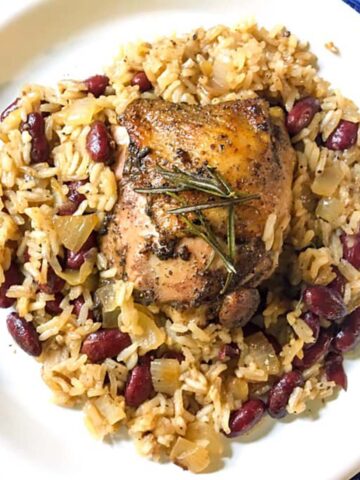
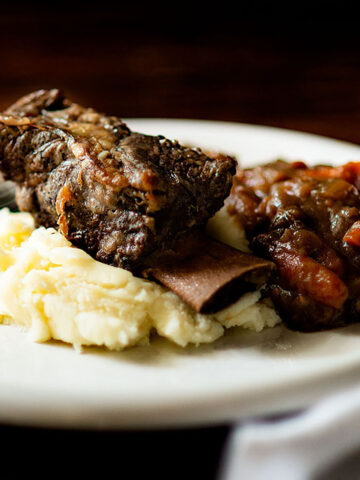
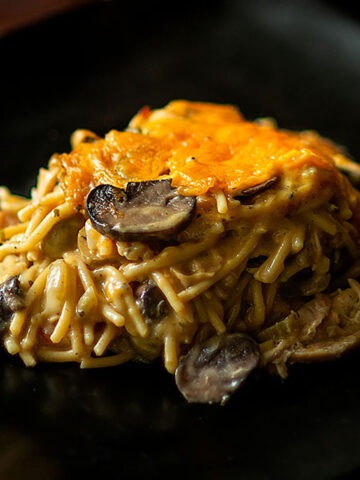




Taylor says
this was delicious!!! Used Okra instead of celery and then poblanos for the pepper. saving to make again, thank you!!
Jeremy Klae says
Hi Taylor! So glad you enjoyed it and I bet that Okra in the was absolutely Perfect! Thank you for taking the time to comment and I hope you find some other recipes on the blog that you enjoy just as much.
DiJaGood says
love this recipe. I used mild hot peppers from our garden.
Jeremy Klae says
So glad you love it! It's definitely one of my favorites! I appreciate you taking the time ot leave a comment and hope you find some other recipes you enjoy just as much as this one.
tina trahan says
I cook the traditional Cajun way and skip the microwave step. Just put the butter and seasoning in the skillet and add the alligator. Same outcome.
Jeremy Klae says
Thank you so much, Tina! That would certainly cut out a step. I appreciate you taking the time leave a helpful comment! Happy cooking.
Chris says
I have a pond of ground alligator, will this work for this recipe?
Jeremy Klae says
It sure should. I don't see why not. I'd love to hear how it turns out using ground alligator if you have a chance to let us know.
Megan says
I made it. I live in Boise Idaho. we can't hunt alligator, but I found it. delish
Jeremy Klae says
Fantastic! I'm so glad to hear that you were able to find some alligator and enjoyed the recipe. I hope you find some other recipes to try as well and I look forward to hearing back from you again soon.
Kevin says
Recipe came out perfect, we are big alligator hunters and have been looking for another way to cook it other than fried. This was awesome! Thank you!
Jeremy says
So glad it turned out for you! I've always wanted to go alligator hunting, at least I think I have...that could be a different story once I got out there! Either way, I do love the meat! Thanks for taking the time to comment, and I hope you find some other recipes you'll enjoy as well.
Raetta Thomson says
Where does the parsley and tomato paste go?
Jeremy says
Hi Raetta! Thank you so much for pointing this out to me. I can't believe I forgot this in the recipe card. Add the Tomato Paste to the roux before pouring in the Chicken Stock and Water. Stir to combine, then add the parsley and remaining ingredients. Thank you for checking out this recipe, and I you find some others you'll enjoy as well.